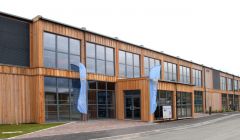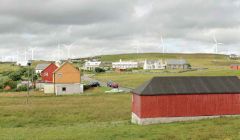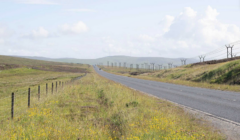Council / SIC faces complaints after backing wind farm
SHETLAND Islands Council on Tuesday gave their backing to the massive Viking Energy wind farm project.
A recommendation by the council’s own planners to object to the 127 turbine development on environmental grounds was rejected by nine votes to three, with one abstention.
Seven councillors refused to participate in the debate due to their conflict of interest, while two councillors were away.
The SIC will now recommend that Scottish ministers approve the 457 megawatt wind farm to be built on high peat moorland in Shetland’s central and north mainland.
Immediately after the meeting, anti-Viking campaign group Sustainable Shetland announced they would be reporting elected members who participated in the debate to the Standards Commission and to the Office of the Scottish Charity Regulator (OSCR) for alleged breaches of the code of conduct.
Councillors are perceived to have a conflict of interest in the Viking development as they control a 45 per cent share in the wind farm as trustees of Shetland Charitable Trust.
The council had initially set up the Viking Energy Partnership with power giant Scottish & Southern Energy in 2003 before handing their share over to the trust.
After three and half hours of debate and statements from objectors and supporters, it was Shetland South member Rick Nickerson’s motion to reaffirm the council’s initial support for Viking Energy that comfortably won the day.
Seconded by Shetland North councillor Addie Doull, Mr Nickerson said that in his view the economic and community benefits of the massive development outweighed any negative impacts.
His motion called on Scottish ministers to impose appropriate planning conditions to “ensure that the project minimises any environmental and health impacts which might occur during its construction, operation and ultimate decommissioning phases.”
A motion put forward by Shetland West member Gary Robinson to follow the council’s own planning department’s recommendation to object to the project in its present form only received three votes.
Become a member of Shetland News
A further motion by Lerwick South councillor Jonathan Wills suggesting Scottish ministers call a public local inquiry had just four supporters.
Tuesday’s hearing gave campaigners both for and against the project the opportunity to air their views prior to councillors debating the issues and coming up with a recommendation that will now be submitted to the Scottish government’s Energy Consents Unit.
Had the council objected, the government would have had to call a public inquiry. It can now either make a decision on the application without any further input early next year, or call a public inquiry if it feels the issues raised need further public scrutiny.
The Shetland community is deeply divided over whether the £685 million project to build one of Europe’s largest onshore wind farms will be an investment to secure future prosperity or will lead to the ruin of island life.
The meeting in the main hall of Lerwick Town Hall was observed by around 80 people.
It kicked off with a short presentation by SIC head of planning Ian McDiarmid, who introduced his 69 page report and explained why he had come to the conclusion the project as put forward to the planning stage would do more harm than good to the local environment.
His position was countered by SIC head of economic development Neil Grant’s short briefing paper on the potential benefits of the project, described as of “paramount economic importance”.
The project would “provide substantial intergenerational economic and social benefits”, Mr Grant concluded.
There followed seven individual presentations from objectors to the scheme, namely Sustainable Shetland chairman Billy Fox, local RSPB area manager Pete Ellis, Nesting resident Ian Malcolmson, former Aith head teacher Jim Nicolson, Kergord resident Evelyn Morrison, semi retired solicitor Richard Rowland from Vaila, and Lerwick resident Caroline Henderson.
Highlighting serious health concerns with regards to the proposed siting of turbines close to homes, Mr Malcolmson and Mrs Morrison’s presentations made the most notable impression on councillors.
Mr Malcomson said the council’s own guidelines on siting of wind turbines recommended between seven and 12 in the Nesting area whereas the developer had plans for 37 machines.
In addition the majority of the 127 proposed wind turbines were planned to be erected less than two kilometres from individual houses and settlements, a proposal that was in breach of government guidelines on siting turbines, he said.
“Viking Energy show their contempt for the local community and blow a hole in their claim that this is a community owned project. It is not!” he said.
Mrs Morrison, who has a brain tumour and suffers from headaches and tinnitus, pointed out that Viking Energy had not delivered on their earlier promise to publish a health risk assessment.
She said she and her husband will have to leave the family home should the development go ahead.
“This has put untold strain on us, it is extremely stressful,” she told councillors. “Please take into consideration the many lives this wind farm will ruin. Look at your conscience and reject it.”
There were three presentations in favour of the development, by Bobby Hunter of the Windfarm Supporters Group, Laura Carse of Pelamis Wave Power, and Yell community councillor Dan Thompson.
Mr Hunter said the proposed wind farm could be regarded as a symbol of Shetland’s commitment towards a sustainable future.
He said the isles needed to make a contribution towards combating global warming, a phenomenon he personally had the chance to witness on a recent holiday to Antarctica.
He said he felt “the tide turning” in public opinion in Shetland and recommended that councillors support the application.
Pelamis project development officer Laura Carse said her company’s plans to develop a 10MW wave farm off the west coast of Shetland would be in jeopardy, should the Viking wind farm not go ahead.
This was because only a project the size of the Viking wind farm would guarantee the subsea cable necessary to export green energy from the isles to the national grid.
She praised “all the ingredients” Shetland had to become a successful player in the emerging marine renewables industry, such as an excellent wave regime, ports and harbours and high quality maritime skills, all well placed to exploit some of the 400 megawatts of recoverable wave energy around the isles’ coast.
Finally Viking Energy Partnership chairman Chris Marden and project manager Aaron Priest made their case before councillors started debating their response.
Mr Marden said the company felt that it had listened to local concerns and had come up with a compromise that should be “acceptable”, having reduced the size of the wind farm from 150 to 127 turbines.
He said Viking Energy was disappointed with the planning report, saying it was “fundamentally flawed” as it only focussed “on the impact but not on the benefits”.
Responding to the health issues raised by Mr Morrison, Mr Marden said it was “standard practice” to apply planning conditions to mitigate against such issues.
Prior to the meeting all 20 councillors present declared their interests as trustees of Shetland Charitable Trust, a 45 per cent shareholder in the venture.
Seven left the meeting either because they declared additional interests as directors of Viking Energy (Caroline Miller, Bill Manson and Alastair Cooper) or as remunerated chair and vice chairman of the charitable trust (Bill Manson and Jim Henry).
Councillors Cecil Smith and Allison Duncan left as they felt unable to debate the issue as a trustee of the charitable trust, and councillor Andrew Hughson did not take part, because his son was contracted to Scottish and Southern Energy, the other main shareholder in the wind farm project.
Kicking off the debate, councillor Nickerson circulated a prepared motion calling on the council to reaffirm its support for the project. He was immediately seconded by councillor Doull.
Next to speak was vice chairman of planning Gary Robinson who said he remained “unconvinced” as to where the balance lies between the impact and the potential benefits.
He said he supported the “professional report” by planners and subsequently moved the recommendations to object to the proposed development.
“That does not mean that there will be no wind farm, it means the application will be properly scrutinised,” he said.
He was seconded by Florence Grains, a former chair of the planning board herself.
Development chairman Josie Simpson said that Shetland’s past and future was closely connected to the sea and as such the marine renewable energy industry was to be the next big thing in the isles.
In order to bring that industry to Shetland, the inter connector was needed, and the only way to get the link into the national grid was by building the Viking wind farm.
Planning chairman Frank Robertson meanwhile said that he was “100 per cent in favour of renewables” but did “absolutely fully concur with the determination by the council’s planning officers”.
He added: “There is the potential for a wind farm of reasonable size”.
Betty Fullerton, Laura Baisley, Gussie Angus, Jim Budge, Robert Henderson and council convener Sandy Cluness all spoke of their difficulty reaching a decision on the protracted issue and expressed concern over the health issues raised.
They all voted in favour of Mr Nickerson’s motion after he had agreed to include in his motion a call for the Scottish minister to ensure that health impacts would be minimised.
Councillor Jonathan Wills, who had abstained during the first vote, moved a further amendment calling for a public inquiry.
He said that elected members were once again going against planning advice, and that just nine out of 22 councillors had made the decision to support the Viking application. However he only received the backing of councillors Robertson, Robinson and Grains.
Reacting to the council decision immediately after the meeting, Aith resident Jim Nicolson said he was “very disappointed”.
“This issue is of such importance that we need a public inquiry to enable deeper consideration of particularly the health issues raised here today,” he said.
Mr Malcolmson said he was “desperately disappointed” and that “a little piece of my love for these islands died today.
“We now live in a community willing to sacrifice the health and well being of some members of the community to serve the financial benefit of the rest of it. I did not believe this would happen in Shetland.”
Billy Fox said Sustainable Shetland had in the past “very deliberately” not reported any elected members to local authority watchdogs, but felt they now had no other choice.
“Councillors have effectively acted as developers here today. They all declared an interest but remained at the meeting. They have not represented what I believe is a majority opposition to this project.
“We always felt that there was a possibility that democracy and common sense would break out in the town hall, unfortunately it has not happened.
“We have already taken the decision in committee that once we reached this stage, if councillors voted to accept the VE proposals, we would report each of these individuals to the Standards Commission and also to OSCR, and that is now going to happen,” he said.
Become a member of Shetland News
Shetland News is asking its many readers to consider paying for membership to get additional features and services: -
- Remove non-local ads;
- Bookmark posts to read later;
- Exclusive curated weekly newsletter;
- Hide membership messages;
- Comments open for discussion.
If you appreciate what we do and feel strongly about impartial local journalism, then please become a member of Shetland News by either making a single payment, or setting up a monthly, quarterly or yearly subscription.















































































